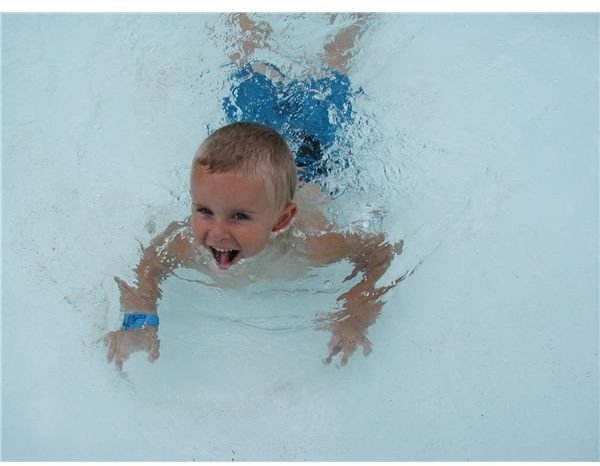Teaching a Toddler How to Swim: Fun and Safety Lessons in the Water
With the amount of water around in pools, lakes, and the ocean, it is wise to begin toddler swimming lessons at an early age. According to the new guidelines from the American Academy of Pediatrics, doctors are saying that they had originally said swimming lessons were fine for children younger than four; now the group feels formal lessons as young as one are fine if the child and parents are ready.
In school settings, teachers can work with toddlers in small wading pools. Limit the number of children you are working with or have other adults to help teach and supervise with your group. The goal to these lessons are to help children become comfortable putting their faces in the water, learning how to blow bubbles, and begin to kick their feet. These pre-lessons are the basics for beginning swimming. Keep the lessons short - no more than twenty to thirty minutes a day.
Lesson One
The basis of lesson one is getting the toddler accustomed to having water in their face. Pretend to do body washing. Invite the toddler to pour water from a cup over your head and pretend to wash your hair and face. Invite the toddlers to mimic you as you pour a small amount of water over their head. Help the children wipe their eyes and praise their success.
Next, show the toddlers how to be alligators by putting their hands on the bottom of the wading pool and stretching out their legs for tails. Have your little alligators crawl forwards and backwards in the pool. The little ones can dip their head in the water - but do not force them if they resist.
Lesson Two
As you begin the next lesson, have the children review what they previously learned. This time have the toddlers get used to the water by playing circus. They can be elephants by cupping water in their hands and pouring it on their heads and faces, galloping horses (splashing the water) and tightrope walkers (all fall off the rope into the water). Review how to wipe their eyes and that everything is all right and fun.
Next, teach the toddlers how to blow bubbles. Children who are busy blowing bubbles hardly notice the water on their faces and because they are blowing out, water does not go up noses or down into tummies. You can start with a short straw where toddlers blow bubbles in the water. Some children may be ready to blow bubbles directly in the water. Tell them to pretend they are blowing out candles on a birthday cake by placing your fingers (the candles) above the water and slowly lower your hand where the toddlers are blowing in the water. Again, do not push children who are not ready for this activity. Swimming should be fun and we do not want to place fear into toddlers.
Lesson Three
Again, review everything from the past two toddler swimming lessons and then introduce kicking in the water. First the toddlers can sit on the edge and kick their feet. Next, you can put them in the alligator position and let them kick their legs. Support their body so they do not sink to the bottom and get scared.
Water Safety Rules
Prevention of accidents in and around the water should be the single most important concern for those responsible for the health and well being of children. Knowledge of good safety practice helps reduce the possibility of injury and tragedy in the water. Training, experience, and skill can be acquired in most states through water safety classes from the American Red Cross. Practice the rules below at your center:
- Never allow anyone to swim alone - children must be supervised at all times near water, even a small amount.
- Make sure all pools are emptied after use or locked within a fence.
- Maintain clarity and sanitation of the water, as recommended by local health departments.
- In regular pools, keep lifesaving equipment handy such as a ring buoy or reaching pole.
- Avoid glass or sharp objects near the pool area to prevent cuts.
- Know CPR and emergency numbers for help.
- Stay out of water during electrical storms.
- Avoid over-exposure to the sun.
- Never substitute inflatable devices for swimming ability.
Begin by making sure the children are comfortable with water. With these basics children can progress to more formal lessons at pools with water instruction programs conducted by the Red Cross or other local water safety divisions. Swimming is fun and a vital lesson all children should learn.
References
- Photo credit: infographe_Elle, http://www.morguefile.com/archive/display/118865
- Pre-Swimming: Fun and Safety in the Water EverydayTLC Newsletter July 16, 2001
- New Pool Safety Guidelines
- American Red Cross, Summer Fun Includes Learning Basic Water Safety Rules
